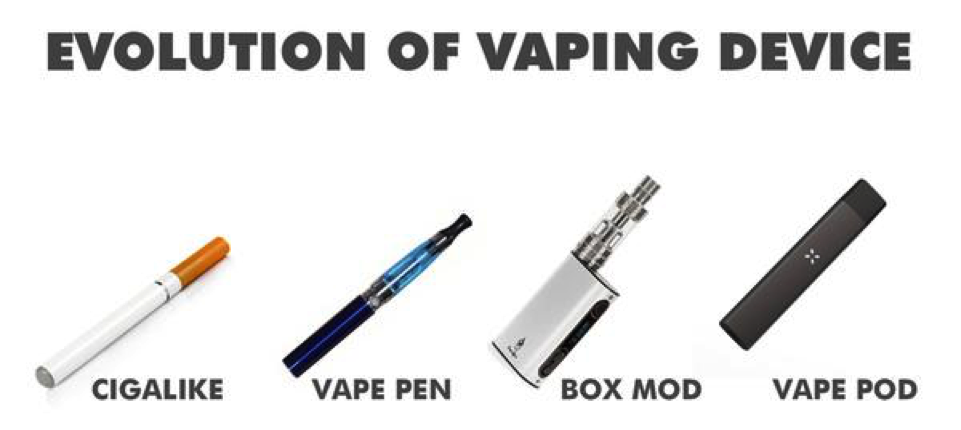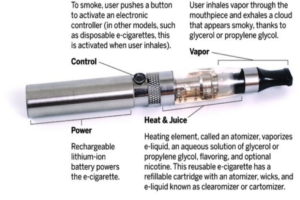I found something in my middle-schooler’s bedroom that looked like a liquid-filled pen with a mouth-piece. My friend told me it was used for “vaping,” whatever that is. If she’s right, is this something we should be worried about?”
The movie Ben is Back, starring Julia Roberts, should be watched by every parent with a teenager—with the teenager in the room. It’s a no-holds-barred story of substance abuse, accurately and painfully presented. It’s what we see every day. The opening scene shows a young man apparently stalking an empty home, peering through curtained windows. He occasionally pauses, takes something from his pocket, and vapes. The writers and director were subtle yet intentional in presenting this, and we appreciate it. And yes, this is something you should be worried about.
E-cigarettes hit the market in 2003, starting in China. Since then, their use has exploded, attracting the attention of “Big Tobacco.” These giant corporations saw another way to hook people on nicotine and make a lot of money. Initially in the U.S., e-cigarettes were produced by small companies, but in short order, most have been bought by the usual suspects—R. J. Reynolds, Altria (previously Phillip Morris), among others. Globally, this has become a $5 billion a year business.
What do these things look like?
We have to pay attention, because these things continue to evolve. At first, they were designed to look like a regular cigarette. You’d “smoke” one, then throw it away. The need for stronger nicotine concentrations and less detection led to pen-style products and then tank-style devices. “Pod-mod” models are rechargeable devices that have replaceable cartridges that can contain flavorings in addition to nicotine. One of these “pod mods” is the JUUL—a device that looks a lot like a USB flash drive. It’s small, discrete (by intention), and can be difficult to detect in school and other public settings. This is where the term “Juuling” comes from.
While the devices might differ in appearance, they all function in the same way. There’s a cartridge that contains a liquid (nicotine, flavorings, and other stuff), an “atomizer” (a chamber that vaporizes the liquid with a heating element), and a battery. The user activates the device by either inhaling or pressing a button, causing the atomizer to heat and vaporize the liquid. The vapor is inhaled (hence the term “vaping”), the nicotine is delivered, and the device is hidden away. There’s no combustion and no smoke.
As a parent, it’s important for us to know what these things look like and how they work. But we need to remember that the manufacturers of these devices are intent on increasing sales, increasing the number of users, and doing everything they can to make the delivery systems as attractive as possible. They’ll continue to evolve.
So in this “juice” compartment—where the liquid is stored—what do we find? It’s not just nicotine, though that’s the major component. The average amount of nicotine in a regular cigarette is around 12 mgs, though manufacturers learned a long time ago to manipulate this number. The nicotine content of e-cigarettes can range from 0 to as much as 24 mgs.
Other chemicals include things like lead, tin, nickel, arsenic, propylene glycol, ethylene glycol, and a host of flavorings. It’s these flavorings that have drawn a lot of attention, since the obvious intent is to attract younger “vapers” by offering choices such as fruit, candy, soda, and alcohol flavors.
I thought these e-cigarettes were designed to help people stop cigarette smoking. Isn’t that a good thing?Anything that helps people stop smoking is a good thing, and e-cigarettes were promoted to do just that. The reality is something different. To date, most large studies have not demonstrated a reduction in cigarette smoking with the use of e-cigarettes. Rather, a whole new industry has been born and evidence is mounting that non-smokers that start vaping may ultimately become cigarette smokers.
But who are the “vapers” among us? It’s a growing number. A few years ago, as many as 1 in 6 adults were classified as “ever-users”—someone who vapes on an infrequent basis, with about 4% of us vaping on a regular basis. The real problem has been the exploding use among our young people. In 2018, 21 % of high school students acknowledged current use of e-cigarettes (almost double from the prior year), and around 5 % of middle-school students were vaping. Staggering.
If these numbers continue to rise, we need to know what kind of effect e-cigarettes will have on the health of our children. As “Big Tobacco” has long known, it’s all about the nicotine. This chemical hits most of the pleasure points in our brains and is extremely addictive—some substance abusers tell us that it’s more addictive than cocaine. By itself, nicotine has not been proven to increase the risk of cancer or heart/lung problems. It’s the vehicle—the delivery system. With traditional cigarettes, it’s the tars and other chemicals that kill us. With vaping, those things aren’t present, but a multitude of chemicals are being inhaled along with the nicotine. It’s too early to assess the cancer risk of e-cigarettes, since it takes as much as 20 years for some things to declare themselves. Asbestos is a good example. However, there is growing evidence that vaping reduces lung function and may be associated with chronic cough and asthma among adolescents. Earlier, we mentioned “flavorings.” When these chemicals are vaporized, a host of other agents are created, some of which are known pulmonary irritants and others which are associated with several lung diseases. The devices themselves can prove dangerous, with documented instances of explosions that lead to burns and chemical injuries. In the past few weeks, there have been dozens of reports of seizures among young vapers, probably due to accidental or intentional enhancement of nicotine concentrations. We don’t know the effects of e-cigarette exposure during pregnancy, but there is evidence that passive exposure produces measureable levels of nicotine in the non-vaper.
What should really concern us is the intentional creation of nicotine-dependence among our young people by these manufacturers. By attempting to “normalize” smoking behavior, we’re going to see an increasing incidence of vaping, with its known and unknown dangers, and a potential increase in the use of “combustible” tobacco—traditional cigarettes.
None of this is any good, and as parents, we have to be vigilant. In addition to tobacco-free school campuses, we need to insist they be vaping-free as well. We have to know about this stuff and be advocates for our children. And we have to talk with them. You can be sure Big Tobacco is.
…
This is an excerpt from the new book I’m writing with pediatrician Dr. Robert Alexander. The book will address 100 questions from parents regarding their children’s health. Feel free to email us with questions: askthedox@yahoo.com



Add Comment